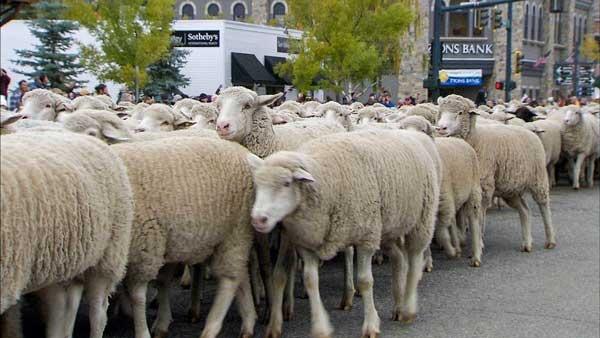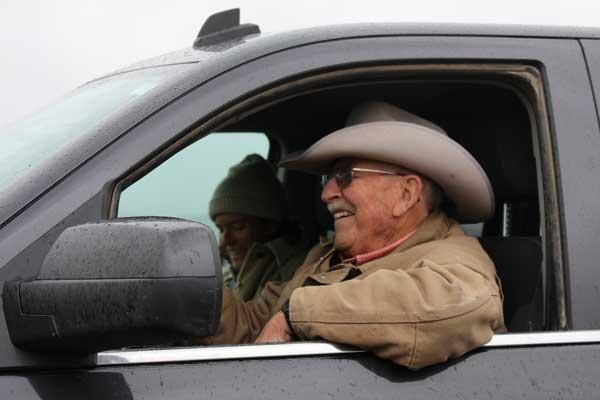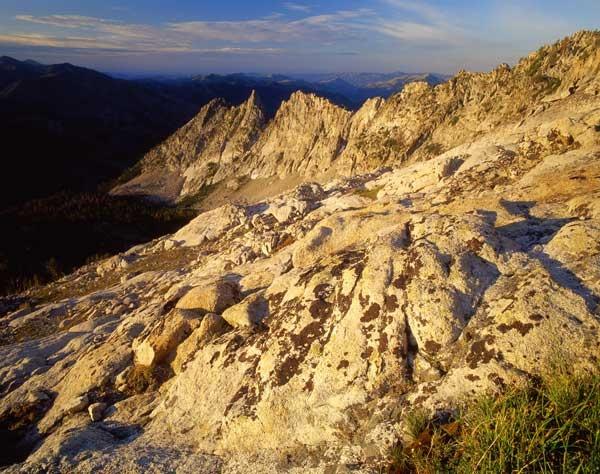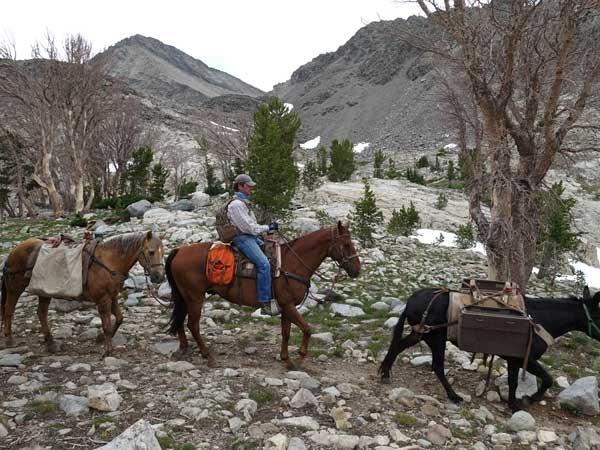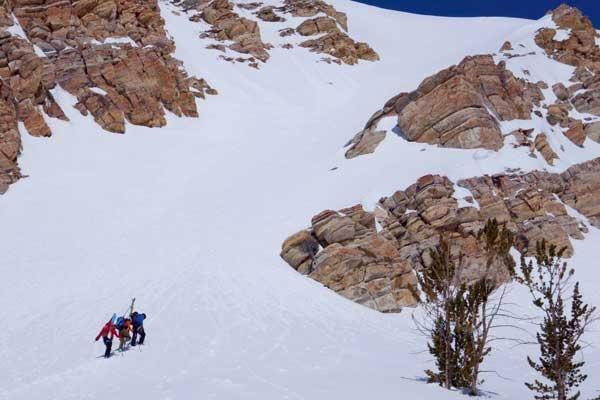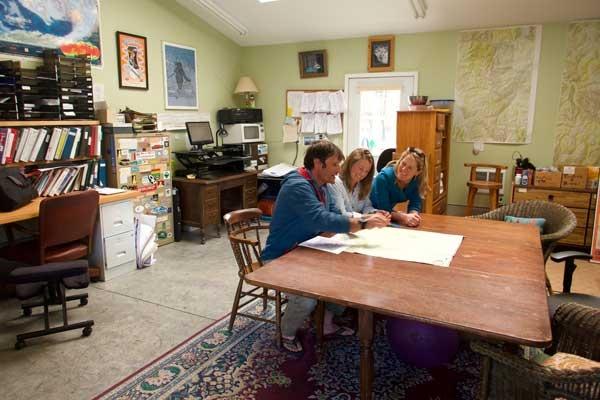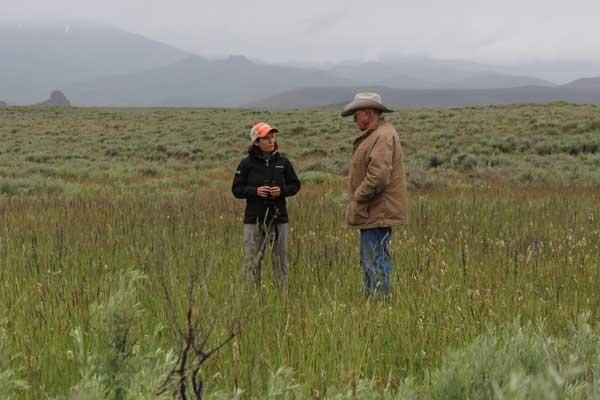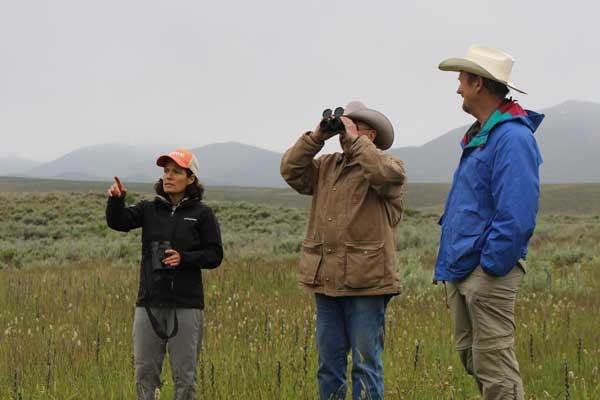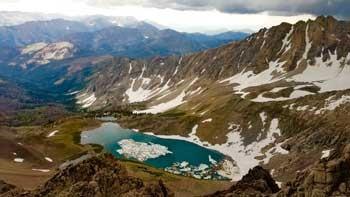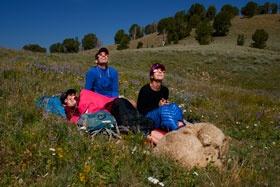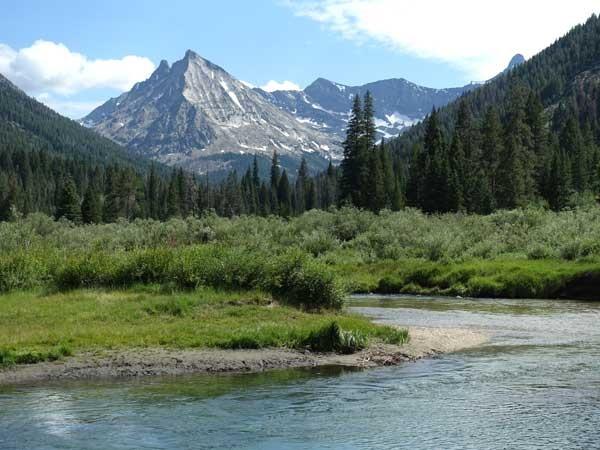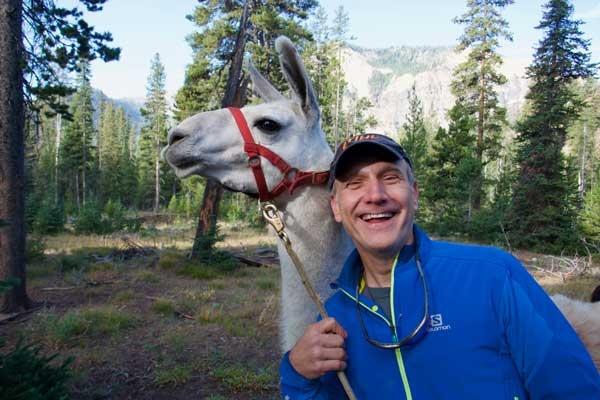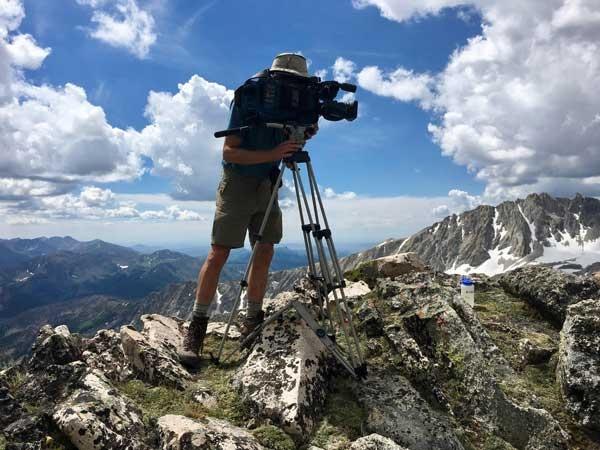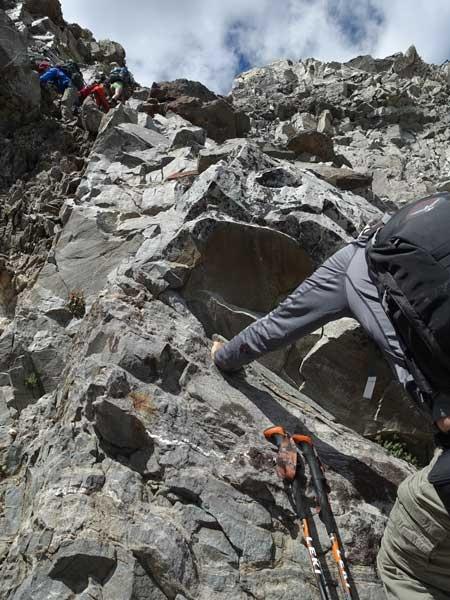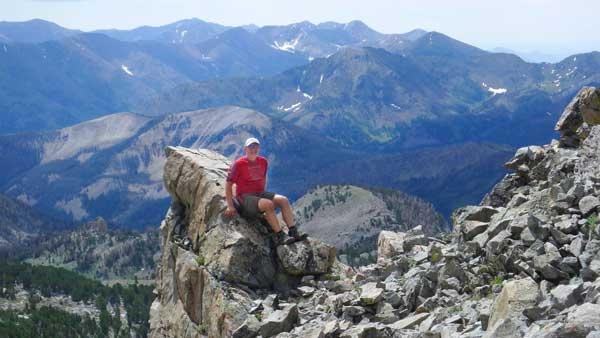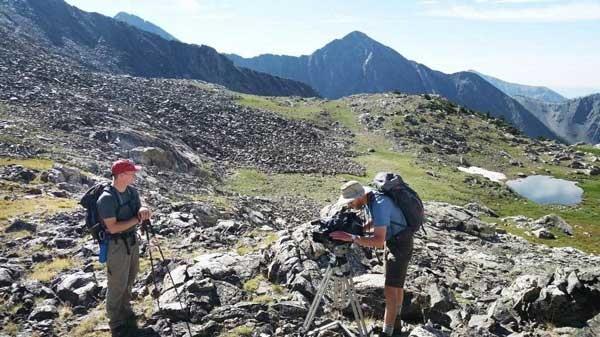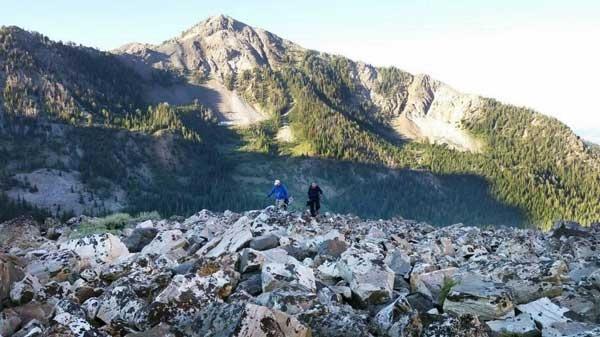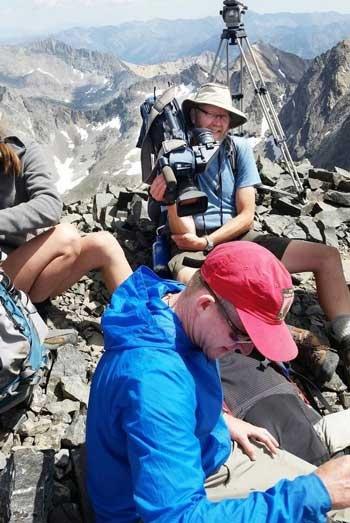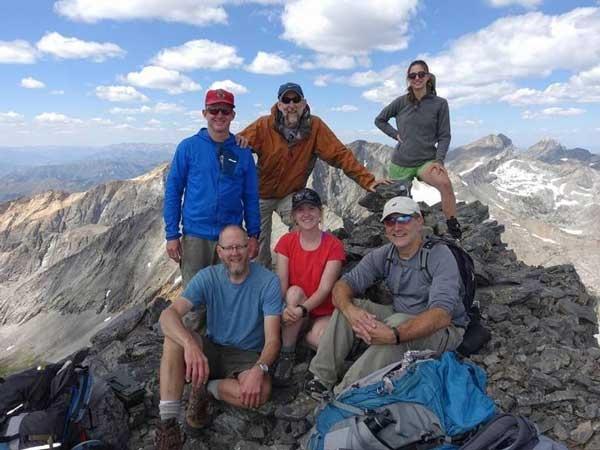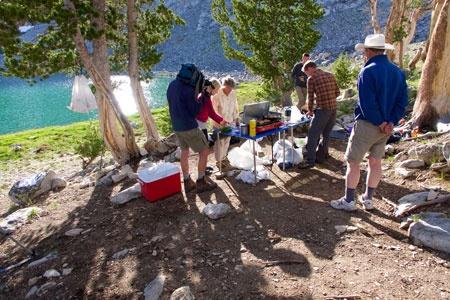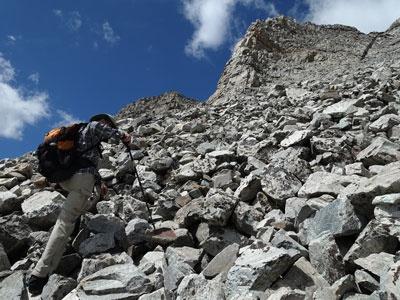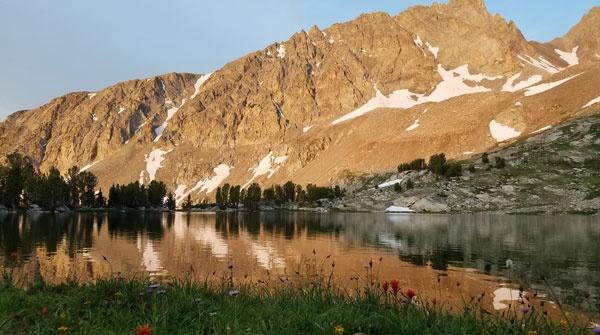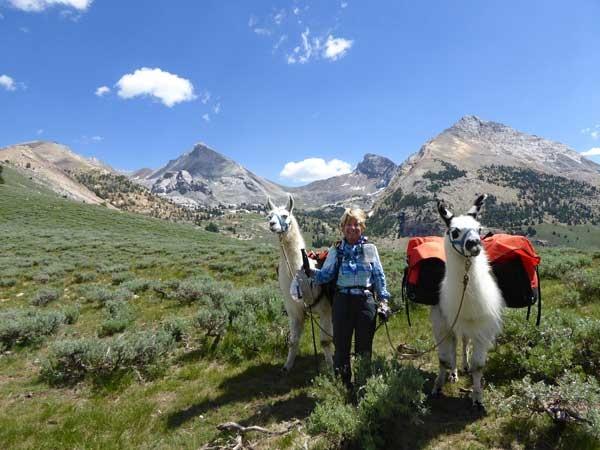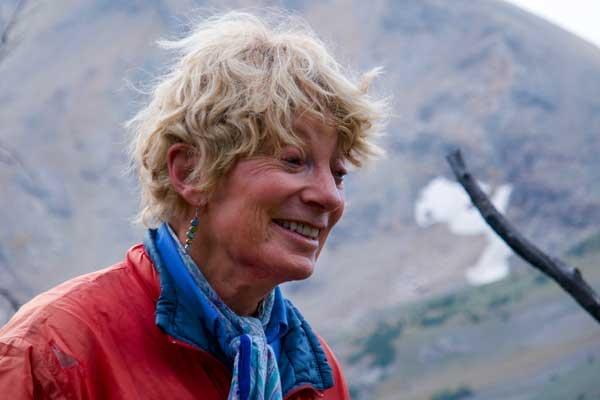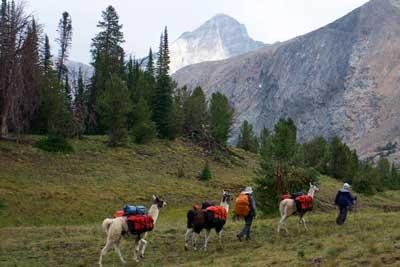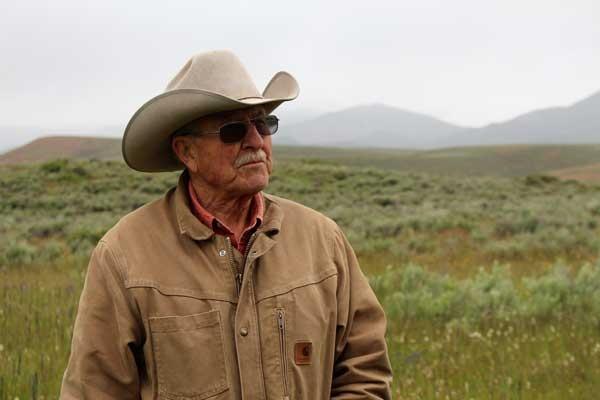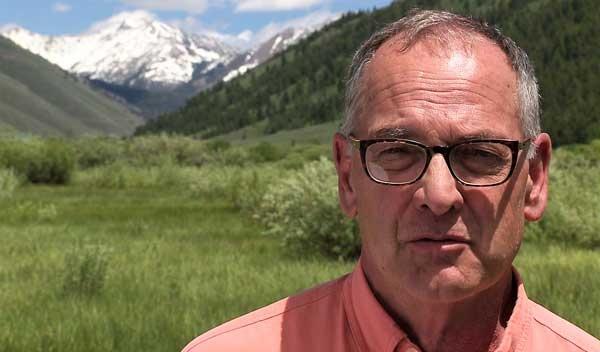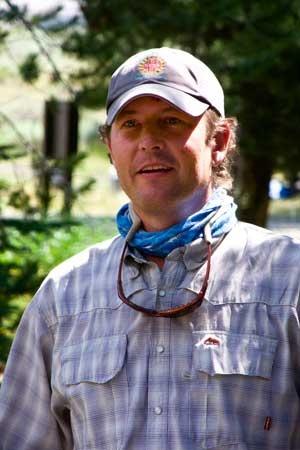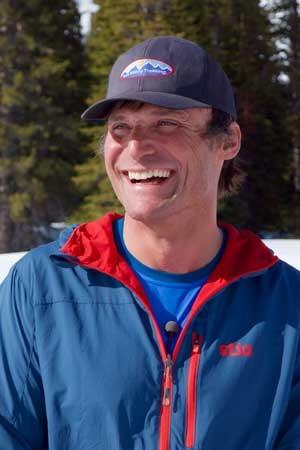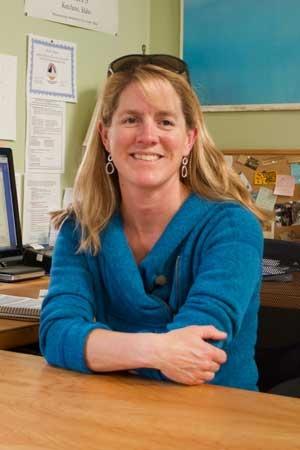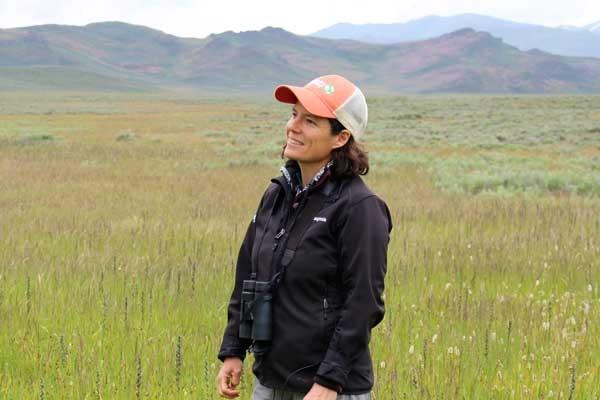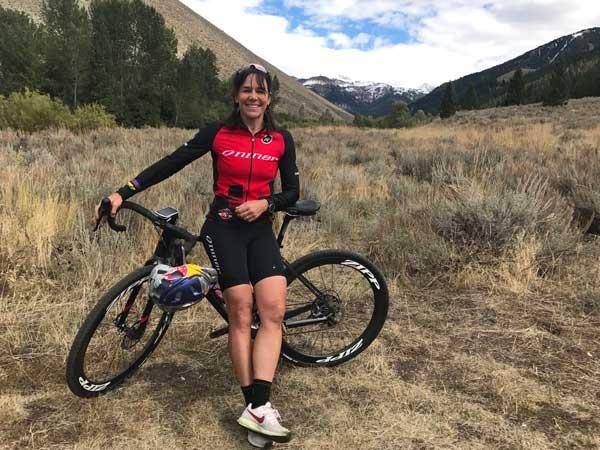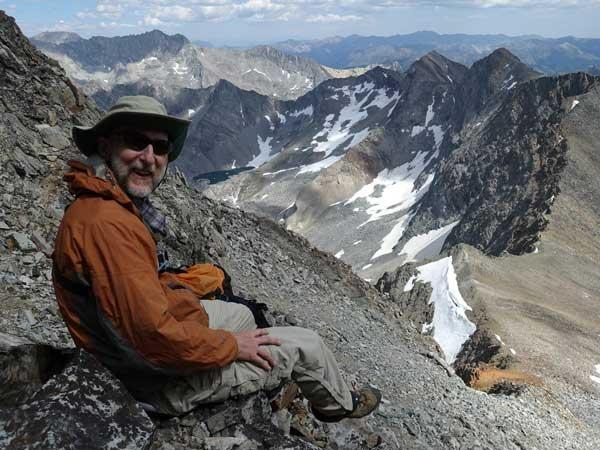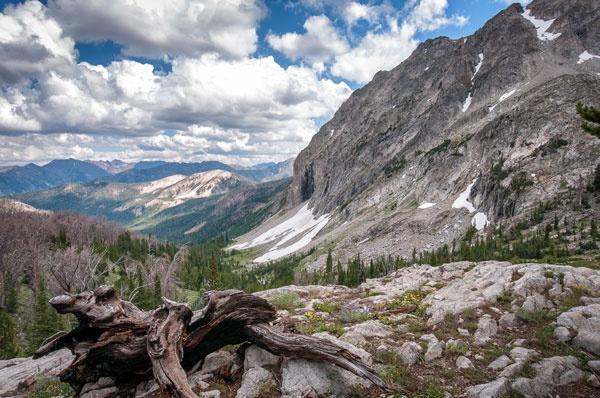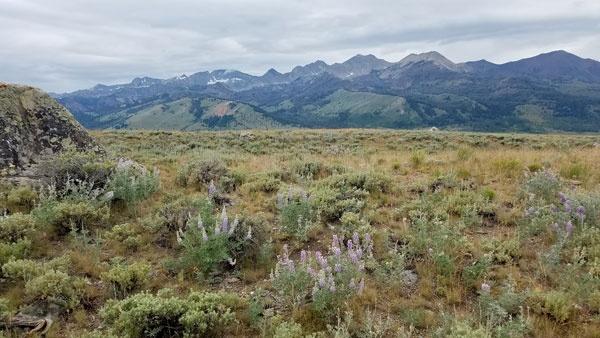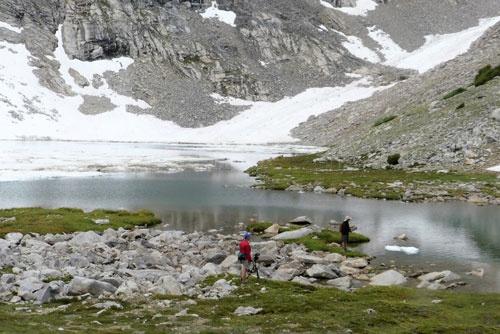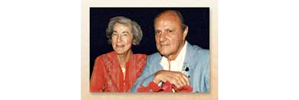Into the Pioneers
Positioned between glamorous Sun Valley and desolate Craters of the Moon, the Pioneer Mountains are, for many, just a blank spot on the map. The Outdoor Idaho crew set out to change that, exploring the valleys and the tallest peaks of Idaho's second-highest mountain range. This is not official wilderness, but it's every bit as wild as the nearby Boulders and White Clouds, with a rich history and diverse landscape sure to inspire and intrigue.
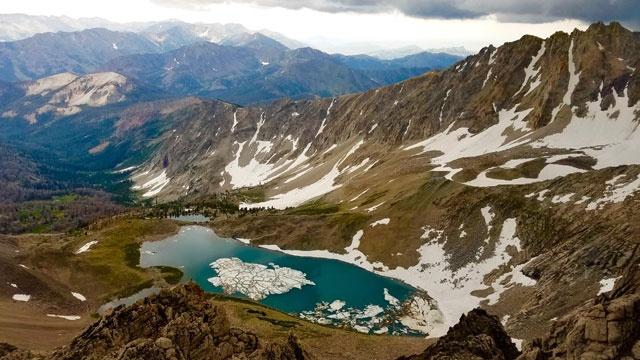
Perspectives and Perceptions of the Pioneers
Photos from Bob Jonas Interview
Sun Valley native and former outfitter. He was in the process of completing a nearly 500 mile 'walk-about' through central Idaho's wild areas when we caught up with him in the Pioneers in September of 2017. This interview was conducted by Bruce Reichert.
I grew up in Ketchum as a kid and skied Baldy all those years, and then driving across the Snake, there's this beacon of those three pyramids. That was -- even more than Baldy and the Smoky Mountains -- the home range; it was at hand. I use the word "beacon," but that was the first siren that got me into the high country, exploring the Pioneers.
And they're high. Compared to the Smoky, the Sawtooth, the Middle Fork country, the Crags; they're a thousand feet higher; the main crest is 11,000 feet. And the net of that is you have some really big cirque basins. And so those big cirque basins really appeal to me, and some of them are long.
These peaks have a backside. From every point of the compass they're unusual. And many of those because they rear up out of the landscape, they're shallow cirques and all around them. And so to say that you've been to the Hyndmans, you've got to go to the other side, too; it's an entirely different aspect in character. It's really interesting. It's a broken country. It's a big, high country. It encloses special places.
Out there on the Snake Plain is where my grandparents' ranch was, where John Peavey is. And so I wanted to end (the walkabout) down in that country, because this ridge I'm going to go down encloses a country called Muldoon. And another aspect of the Pioneers is that southern end. That's where you have antelope that come up into the valleys. If you're in Hailey and you go east, you drop over the top there into Muldoon country, and that's the Little Wood River. Not many people get up in there. And it's more of a basin and range type of feeling up in there. So, yeah, I wanted to end it that way.
The first thing that comes to mind when I think of the Pioneers is that view from the summit of Baldy. Everybody that skis one of the most fantastic ski mountains in the world looks to the east where the sun rises and there's those three triangular peaks; that's the Pioneers. That is an image that at one point in time, you know, I kept thinking, "Hell, I'm only skiing a square inch of terrain around here. It's time to leave this great mountain and really explore. I'll start with the Pioneers."
In fact that's when I was looking at establishing Sun Valley Trekking; I was skiing the different ranges around, and did ski into the Pioneers. A friend and I skied essentially this Baldy side of the Pioneers, skied the slopes. And decided that, maybe it's a bit too far to get in there from Triumph Mine. I mean, it's great once you're there. But, anyhow, that was one of the first places I started skiing, in the European jargon, "off piece."" For us, back country.
People are looking for new experiences, especially if you're a powder skier, because Baldy -- one of the great mountains -- by 10:00 a.m. it's shredded. So, people are going back country, and that's the place that really attracts the skiers today. That's enjoying a boom.
Is wilderness going to happen in the Pioneer anytime soon? That's a good question. I've felt that because we have such a great central Idaho wilderness -- the White Clouds and the Boulders and it's the Frank and the Sawtooths -- that our legislators being conservative are not going to want to link another wilderness to that area. But I'm hopeful, because as they say, it's extremely high, and we might well have that, especially if we get the next generation calling the shots and pushing for these things.
I've devoted over the last ten years of my life to an organization I founded, called Wild Gift, and that's to support a new generation of leaders that build community. They're in balance with the resources and gifts of the natural world. And some of them are telling me they're getting into politics. I say, you damn well better.
Photos from Sarah Michael Interview
A community leader and former Blaine County commissioner. We met up with her in the Pioneer Mountains as she was finishing up a 2½ month trek through central Idaho with her husband, Bob Jonas. This interview was conducted by Bruce Reichert.
The Pioneers, I call them the Himalayas of Idaho, because you look out across the top of Baldy and the Devil's Bedstead behind me and you see the Hillary Step; it's very similar to the profile of Mount Everest. The peaks just jut out at you once you get into the heart of them. And without a lot of trees and with these big cirques, it really reminds me of the Himalayas. And it's pretty untraveled and untrampled. So they're my Idaho Himalayas.
I think that the Pioneers epitomize a landscape of collaboration. When I was involved in 2000 with the skier snowmobile conflict over the use of snowmobiles up where the Pioneer Yurt is, the skiers and the snowmobilers got together and worked really hard over a ten month period and came up with a solution.
Then a few years later, because of wolf introduction, there were conflicts between the sheepherders and wolf packs in the Pioneers. And as a Blaine County commissioner, we created the Wood River Wolf Project and got together with ranchers and came up with nonlethal means to try to keep wolves away from livestock without having to shoot them.
And that was followed up by the Pioneer Alliance. And that's a group working with the Wood River Land Trust, The Nature Conservancy, Fish and Wildlife, to create a place where you can have ranchers ranching; you can have conservation groups with the pronghorn wildlife migration corridor; and ranchers wanting to sell out to conservation buyers, not to sell out to subdivide.
And so here is a landscape, it doesn't have the development pressure, and you have people willing to sit down and talk to each other about, well, let's come up with solutions. How special is that in this day and age to have people sit down, different points of view and come up with solutions so that we all can enjoy what we want! The ranchers can still ranch, and the recreation groups can still recreate, and the hunters can still hunt.
And it's just a special place. And collaboration is key to the success of why it's so special.
Photos from John Peavey Interview
Sheep and cattle rancher at the Flat Top Ranch, the largest tract of private land in Blaine County. He is also the originator of Ketchum's Trailing of the Sheep festival. This interview was conducted in 2017 by Bruce Reichert.
I've said before, you don't know what pretty is until you've been to Muldoon in the spring of the year to see all the flowers and the wonderful grass and the big open landscapes.
I think it's the animals, the wild animals and the domestic animals and seeing how they all prosper and can raise their young, and the sheep and the cattle and the antelope and the elk and the deer. And we have pretty big bunches of sandhill cranes that come in and raise their young on the meadows. It's the seasons as they change, and you drift back and forth across the real estate with the seasons. It's pretty neat.
You have to learn how to work with the seasons, you know. We've learned long ago to take our livestock to a lower elevation to winter, so that you didn't invest a great deal of the money that you make in a wintering operation someplace.
And for years the ranching community was getting further and further in the hole with mortgages being a real difficulty for families to survive and so forth. And then the Nature Conservancy came along and the Natural Resources Conservation Service, and literally bailed a lot of ranching operations out. And we're almost operating without any debt, and that's unheard of in farming and ranching.
Tess O'Sullivan helped us put our conservation easement together and spent a lot of hours out here. She may know the ranch better than I do, actually. Anyway, we appreciate the Nature Conservancy, and they do a lot of very, very good, worthwhile work.
It depends on the ranching family how they want to structure it, but, basically, you're precluded from putting big housing developments in, golf courses, tennis courts. And thanks to a lot of help from the community, they appreciate the open space and the wildness. And, you know, it's a long drive to the nearest Walmart!
We do the Trailing of the Sheep. My wife and I started that. In Carey people were laughing, "You're kidding me, anyone want to come out and watch a damned band of sheep going down the road? You gotta be kidding me." But it's one of the charming things about this festival. We're coming through town regardless. It's not make believe. This is a real thing.
They're giant peaks, you know. I mean, it gets up almost 12,000 feet. And we run sheep up on the shoulders of the Pioneers, the very highest of them, and share that real estate with a lot of hikers and so forth. And there's some problems that we don't have in other areas with interaction between hikers and our guard dogs that we use now to protect the sheep, from not just coyotes, but wolves, and so that makes it a little more complicated.
I think all the animals suffered with the severe winter last year. It came on, and it just did not let up. I mean, every two or three days you've got a big bunch of new snow. And even long legged animals, like moose and elk, were having difficulty. And I think the deer took it in the shorts. Fish and Game tells me that they lost a lot of fawns. They usually do, but not to the severity that they did. And I suspect some of the young antelope didn't make it through the winter, either.
You see a lot of them because they're out in the open. They want to be in wide open real estate, not hidden in a bunch of willows. You know, you see deer for a very short time, and they're off up over the ridge. By the antelope are out there. They may run a mile or two or three, but they'll still be out in that open country, looking around and making sure nobody's sneaking up on them. They're a wonderful animal; you see more of them than you do the others.
With well managed ranching operations, the forage available to wildlife is better than unused forage. I mean, the fires that sweep through a lot of our rangeland are there because of underutilization, no consumption of fuel, the regeneration of the perennial plants is dependent on the hoof action of antelope, elk, deer, and sheep and cattle. And so they all complement each other.
There's lot of sheep operations that are no longer here. And one of the difficulties is wintering costs. Alfalfa hay has gotten to be a very lucrative product to raise. The dairies have come up from California and got the price of hay up. So a lot of the sheep people close their lambing sheds down and move south in the winter to lamb on hayfields in Arizona and California. We've done that.
And so there's a lot of underutilization on our deserts south of Carey and out north, in Minidoka, big areas that used to support sheep grazing, especially in the fall before the lambing operations took over in the lambing sheds. And they're no longer there. And I think those rangers could improve and be more fire resilient with some more fall winter utilization.
And that winter utilization is really important because the hay prices are extremely high right now. And cow calf operations all over the state are under a lot of stress. Getting their animals through the winters is very expensive. If we could get some of those areas re-utilized and let people take cattle out there that would stay part of the winter, everybody would be ahead, in small towns, especially.
Out here, it's a solitude that you find, especially over here away from Sun Valley. You know, there's wonderful places to fish. I even enjoy the coyotes in the morning, if you hear them yipping and they're not bothering you. Sandhill cranes are wonderful.
Well, you know, it's a wonderful product, lamb raised on this kind of country, like we saw those young lambs this morning. I mean, you compare lamb meat, or beef even, to the poultry operations where all these animals are bunched together in a football field sized building, each one with about less than a square foot of space to move around in, and you compare that to what we're doing out here, it's pretty wholesome.
I inherited the ranch fair and square. And, you know, that's kind of the way operations really work, is if the family's happy where they are, and they're doing fairly well, they can keep their debts down and pay their bills and maybe send a kid to an expensive college once in a while…
I love what I do. It's a great life. It's a wonderful life. I wouldn't trade places with anybody. I really love this life and have no intention of retiring until they take my pickup away from me.
Photos from Paul Link Interview
Professor of geosciences at Idaho State University. He has spent the past 30 years exploring the Pioneer Mountains. This interview was conducted by John Crancer in June of 2017.
So from the Snake River Plain the Pioneer Mountains go north to the Boulder Mountains. And the divide between the Boulder Mountains and the Pioneer Mountains is Summit Creek, which runs into the Big Lost River. On the west side the boundary of the Pioneers is the Wood River, the Big Wood River. And then the Little Wood River is within the Pioneers. And then the east side of the Pioneers, really, is the Big Lost River.
The key to the Pioneers -- the most interesting thing about the Pioneers - is that in the core of the Pioneers are crystalline rocks; they're middle crustal rocks, metamorphic rocks and intrusive igneous rocks.
The Pioneers are a piece of the middle crust, and they're part of this belt of what we call metamorphic core complexes that extend along the Cordillera down into Arizona. And the core of the Pioneers are rocks which have crystalized under heat and pressure. And some of the oldest rocks in Idaho are in the core of the Pioneers.
And so when I think of the Pioneers, I think of the Pioneer core complex. And the Pioneer core complex is surrounded by sedimentary rocks. And the sedimentary rocks are juxtaposed against the crystalline rocks by a fault, called a detachment fault. And here it's called the Wildhorse Detachment Fault.
And so the Wildhorse Detachment Fault wraps around the west, north, and the east side of the Pioneer Mountains. And then on the south side of the Pioneer Mountains is a high angle normal fault called the White Mountains Fault. And so the Pioneers, the core of the Pioneers is this very discrete crystalline piece of the crust.
And that influences why the Pioneers are different, because you have crystalline rocks at the surface. So there's lots of lakes, cirque lakes, lots of glaciated terrain. The rock is not porous, and so there's a lot of surface water, a lot of streams run all year. And, of course, the Pioneers are famous for the trout bearing lakes, especially on the south side above Copper Basin.
So the foothills of the Pioneers, which is the country around us here, are underlain by sedimentary rocks. Those sedimentary rocks were mainly deposited under the ocean. They've got little fossils in them. And they were deposited 300 to 400 million years ago, in what we call the Paleozoic.
The core of the Pioneers is older. The core of the Pioneers include some rocks which are Archean in age, and so they are greater than 2500 million years old, 2.5 billion years. And so there are very old metamorphic rocks in the Pioneers in the core.
And then there are granites that intrude into the core of the Pioneers that were intruded about 690 million years ago. And that was during the time when North America was just beginning to rift from Australia, from a Pacific continent, and so before the Pacific Ocean even was there.
A lot of the Copper Basin Formation is black, but then there's also some gray rock and then some real red weathering rock that makes talus cones on the hillside. And that rock is folded. And it was folded about 100 million years ago during the time when North America was being compressed and before the crystalline core had been uplifted through it. And so as you go around the eastern and the northern side of the Pioneers, the folds of the rocks are very spectacular, and they're folded sedimentary rocks.
Hyndman Peak is a glacial horn, and that means it's been glaciated from three sides, and it's sort of the remnant that's been cut away from those three sides. And Hyndman Peak is, of course, a landmark. It's visible from the Sun Valley ski area; it's visible from the Hailey side.
One of the interesting thing about the Pioneers that has recently been determined by geochronology is that the Pioneers really started uplifting quite recently, only about 11 million years ago. That's 1,000 feet in 10,000 years. So that's pretty rapid geologic uplift.
And so that's why the Pioneers are so steep. And that in combination with the fact that they're hard, right? They're crystalline rocks, pieces of the crust. They've been glaciated, and so the valleys maybe are flat, but the ridges are very steep. And having walked around a little bit in the Pioneers, I know they're steep! But that's related to this very rapid uplift.
And so you can sort of think of the Snake River Plain going down and the Pioneers going up, and the Snake River Plain filling in with lava and then the Pioneers being this uplifted piece of the middle crust. And that is geologically very recent, like 10 million years.
I enjoy that it's so complicated, geologically. I enjoy there's always something to scratch your head over, always something to puzzle over when making a geologic map. The flowers are always wonderful. It's wet here, so there are big trees. There are trees that are 15 feet in diameter.
And the other weird thing about the Pioneers is that it's so close to Ketchum; yet you go up in the mountains, and you hardly ever see anybody. It's very odd.
But it really is the heart of Idaho to me. It's the most geologically complicated part of Idaho. The Pioneers are the most geologically interesting. I'll stand by that one.
Photos from Bryant Dunn Interview
The 'head honcho' at Sun Valley Outfitters. He and guide Kyle Kimball helped the Outdoor Idaho crew get to Baptie Lake in the Pioneers. This interview was conducted by Bruce Reichert in July of 2017.
The Pioneer Mountains really have a special place in my world. In fact, these mountains were where I went on my first backpacking trips with my dad and brother at a young age. And I can remember specifically going into Betty, Baptie and Goat Lakes as a very young person, maybe seven years old. And to get up to that elevation for a young person, it was spectacular.
This area is unique; I've never forgotten it. I grew up in Seattle, but I always thought about the Wood River Valley and the Pioneer Mountains, and the sagebrush that went on for miles, and the blue lupine that lined the roads like guardrails, and the alpine Lakes and the mountain goats that live around them, and all of the game. It's a very special place to me, for sure.
I'm fortunate to guide all over the world, from the Himalayas in Southeast Asia to the Caribbean and all around the globe, and there is absolutely no place I would rather call home and come home to even after having traveled through some of the most beautiful places outside of the United States.
The trails we'll be covering on horses and on foot today are very representative of the Pioneer Mountain chain: very rough, very rocky, ruggedly beautiful. And you'll want to have your binoculars handy, if you can. But yeah, we'll take it slow, we'll take it easy and we'll get there eventually; and when we do, we'll be over 10,000 feet and the views will be priceless.
I think that we Idahoans are very fortunate to have such amazing mountainous terrain; and every range is unique, every range is different, and has its own wonderful qualities. The Pioneers, for me, demonstrate that ruggedness, that arid ruggedness of the alpine and sub-alpine that make you feel like you're standing on top of the world. I've been on Borah, and I've been through the Sawtooths, and I feel similarly there, but there's something about the Pios; it's just one more degree of wildness and unspoiled majesty.
I think that it's amazing what change you will see in a short period of distance. You can go above tree line where the mountain goats live year round, and in just a few short miles be down into a sagebrush prairie, and all of the climate zones, the microclimate zones that exist in-between those two places, only a few miles apart.
We won't find any blue grouse around here where we stand; we may see some sage grouse on the drive out, but once we get up another 1,000 feet or so and even higher, notice how the bird life changes, and suddenly we'll see blue grouse and no more sage grouse. The deer and the elk are here; the moose are here; the mountain goats are here; the cougars are here; the bears are here; and the wolves are here. Almost every species in the Rocky Mountains exists over the course of our day's hike.
We are not the first people to be frequenting these valleys and these plains here in the Pioneer range. Native Americans have been here for thousands of years; and it was only 140 years ago that that stopped being the norm. So the views that we'll see today have been looked at by men and women for thousands of years. And I think it's important always to remember in Idaho that we do have the direct connection to a human past that was here long before Europeans were here, but human all the same, and I think it's easy to tie yourself to those people, if you remember that as you travel through this country.
Photos from Joe St. Onge Interview
Co-owner of Sun Valley Trekking. He took the Outdoor Idaho crew to the Pioneer Yurt near the base of Cobb Peak in April for some backcountry skiing. This interview was conducted by Peter Morrill in 2017.
When I was about 16, I had the good fortune to go on a trip with a mountain guide in Utah. And I remember looking at them and being like, wow, you do this for a living? And at that moment it was like this is what I'm going to do with my life. And I dedicated my life to becoming a mountain guide since then.
Skiing has always been my first love. And I happened to cold call Bob Jonas, who ran Sun Valley Trekking. And I cold called him because I'd heard of his operation and what he did, which was fairly groundbreaking in building a number of backcountry ski huts and running backcountry ski trips in the wilderness of Idaho. That developed into us taking over the operation.
It just takes looking at these mountains. This is a paradise, a skier's paradise. There's few places in North America, certainly in the lower 48, where there's better terrain for backcountry skiing. I haven't seen it, honestly, in the Lower 48.
It's a magical experience, everything from ski mountaineering off of the big peaks to powder runs on the smaller peaks in the bowls that surround us here. So it's a really special place in that regard. And to be able to build a yurt here in the mountains that we can both guide out of, but also just rent it to the public and have other people experience it on their own, people I've never even met before, it's pretty wonderful to be able to do that.
The mountains, they're moody beasts, and being able to roll with the weather and be able to pick the right slopes and objectives that fit the weather is the art of the dance with the mountains.
The soul of the Pioneers? It lies in the wolverine's heart. Those tracks we saw today, right? Fresh just from this morning, working its way down the slope with a swing step that you can see in the tracks. It's wildness. You know, this place is alive, and this place is magical. And this place is deadly, but it's beautiful, and it's friendly. I mean, this place is a work of art. And to immerse yourself in it and do it in a way that brings respect, puts a smile and joy, you know, and to be able to experience it in comfort with your friends is just it's amazing. And, yeah, this place is paradise.
As we go up in elevation, we move out of the lodgepole pine into the whitebark pines, which are the ancient trees that live in the basins all around the Intermountain West. Generally it's around 9,000 feet where we find the whitebark pines. They're in the wind, they're in the snow. And they are very slow growing trees. Trees in some of these basins are 1,000 years old, even older. So we're talking ancient, ancient beings that are up here. And they've never developed any kind of defensive mechanism for bark beetle because they've never dealt with it before.
And when the bark beetle began to march up with these warmer winters we had about 12 years ago, they were beginning to decimate the whitebark pines. And it was a really sad time, to see these beautiful ancient trees turning red and then dying.
But, ultimately, what happened, we think, is that there was a good cold, early winter about eight years ago that stopped the march of the pine beetle, and we haven't seen it come back. And the result is that we still have many very healthy whitebark pines up in these basins that seem like they're doing great. And we're also seeing many young whitebark pines beginning to grow as well.
Unfortunately, most people don't know the whitebark pine because they're not many people going up to 9,000 feet in these mountains. So the ones that know the whitebark pines are the climbers, the hikers, the skiers, the hunters. But it's unmistakable. It's a land of beauty and magic, and the whitebark pine defines it.
These are some of the biggest vertical relief peaks that we have certainly around Sun Valley. When we compare them to the Sawtooth, these peaks tower over the Sawtooth. And many people think of the Sawtooth as the big range of Idaho, but we're standing right here almost at peak level of where the Sawtooth are. Look up there; it keeps going.
Many people that know this range and that are here frequently refer to them as "The Pios." It's the term of endearment, you know, of your friend. I often refer to it as "The Pios." And we often call this the "Pio Yurt" that's behind me here. But it's the Pioneers.
Ultimately, skiing is about freedom; skiing is about flow. And that's why we love skiing, because we can use these amazing tools - skis - developed in Norway thousands of years ago to flow through a mountain landscape.
And those that come from a resort background are almost always focused on the down. And the down is wonderful. I wouldn't be a skier if I didn't love the feeling and euphoria of the down. But backcountry skiing takes that element and adds in the flow of the up, the flow of the intellectual challenge that is applied to a landscape, to a wild mountain range and being able to navigate through it.
There's no one else around but you and your friends. And it doesn't get any better than that. That's to me the soul of skiing. And it goes back to the dawn of skiing. And we're just continuing that tradition. And it's a beautiful thing.
There's a history here in the Pioneers that's kind of cool, but it goes back to the origins of the Sun Valley Ski Resort. And the Austrian ski guides were brought over to instruct at Sun Valley the opening year. And they were mountain guides from Austria. And they brought them over because they were the best in the world as ski instructors. And they got here, and they looked at Dollar and Ruud Mountain, where the lifts were, and they scoffed. And they looked up here, and they said, "We should be skiing up there, no?"
And you know what happened within two years? They built the Pioneer Cabin. And with a significant amount of effort and money, they put a cabin up on the ridgeline to access these mountains. It only took two years for them to have enough motivation to say, yeah, we got to ski here, ya?
Photos from Francie St. Onge Interview
Owner and chief female guide of Sun Valley Trekking. This interview was conducted by Peter Morrill in 2017.
I think they are the great unsung range of Idaho. Everything in the Pioneers is just sort of ramped up one more. They're exquisitely beautiful. It's one of the most pristine alpine locations I think we have. And there's just something about them. When you're out there in the summer, the wildflowers are just more vibrant. And in the fall, the autumn colors are just more bright and more intense. And the rock, is this incredible quartzite rock that's just beautiful when you're looking at it. You feel like you're in the Alps. You've got beautiful wildflower meadows and bubbling brooks and waterfalls and mountain goats and a lot of wolverine, a lot of wolves, and bear. It's really, really rich in wildlife. And, yeah, it's one of the most special and magical places I know.
If you're looking at it from the Sun Valley area, you've got the Devil's Bedstead off to your left or the north. And then as you work your way over, you're going to see Handwerk, Salzburger Spitzl, Goat Mountain, Duncan's, Hyndman, Old Hyndman, Cobb, and then you get over to Grays Peak in the southern Pioneers. So it's just a series, just a whole crest of incredible alpine country.
If you're looking at the Sawtooths at sunset, it literally does look like a jagged edge of a saw. Whereas the Pioneers, when you're driving up from the south, I always think I see these three peaks, and it's Hyndman, Old Hyndman and Cobb, and they're like this triumvirate together. And they often, to me, look like these old men sort of whispering to each other is what I think of when I see them. They're really distinct, you know, big peaks, as opposed to being a whole bunch of mountains all doubled up.
My husband and I looked for years for a place to create sort of like a school or an outdoor education center, somewhere where we could help facilitate what the traveling on snow, especially in mountains, does for people.
When people are backcountry skiing, the joy that they feel and the peace and the freedom, and the camaraderie they share, the new perspective they have when they come back to town is just life changing. And we just wanted to help facilitate that for people and to share that with people. And so that gives us a huge sense of satisfaction and reward for that.
And so we've been doing it now for about 17 years. You know, we took it over from the founder, Bob Jones, 17 years ago. It's not without its challenges, but it's been absolutely incredible.
When we took over, it was five huts and really just a one man show. And over the last 17 years, Joe and I built it up. We now have six huts that are booked straight through the winter. And we are a team of about ten people that are working full time all winter long.
There's just been a lot of interest in backcountry skiing, especially out of the huts. And it's mountain biking and hiking, as well. And so we've been able to accommodate that growth in interest.
Backcountry skiing is really backcountry hiking and skiing. You spend 80 to 90 percent of your time ascending and hiking on your skis, and only about 10 percent of your time skiing downhill. But those moments when you're going downhill are just so different. It's just like the difference between powder skiing and skiing on the firm, groomed slopes of the ski resorts or the mogul runs of the ski resorts. And I think it's the quality of powder skiing and that sensation that you experience is what people just want to come back for because it's so exquisite and addictive.
You feel like you're flying, but it's this magical substance that absorbs you and yet supports you, and you've got this feeling of being aloft. Powder snow is just the most amazing substance on Earth. It just brings so much joy, and people need that.
The Pioneers are just literally right out the door. They're so accessible. From Hailey and Ketchum you're out at the trailheads in 20 minutes, and you can get up into the spectacular country. And so they literally are this incredibly diverse little mountain range. Only here in Idaho can you drive 15 minutes away from Sun Valley and you've got wolves and mountain goats and wolverine and elk, coyotes, just right in front of you, right across your path.
Photos from Tess O'Sullivan Interview
Protection specialist for the Nature Conservancy. She works on land protection and conservation issues and has helped ranchers with easements on their land. The Nature Conservancy has worked with other groups to also help the pronghorn. This interview was conducted on the Flat Top Ranch by Bruce Reichert in June of 2017.
So we are here in what I would call pronghorn heaven, right here in one of these gorgeous meadows on the Flat Top Ranch. And we're standing in the camas, lily, and biscuit roots, and just lots of dense and lush vegetation. And it's really a wet area. Every year these meadows are wet, and they're so important.
And this is a place where the pronghorn come home and begin their summer. And then they have this long migration that they make every year, two times a year, and they come back to these areas in the spring. And there's a good reason. They have found that these are wonderful places for them to raise their families, and have this really nurturing vegetation that can help them survive their year.
In the winter they're surviving on just sagebrush that they're pawing through the snow to get and a little bit of bitterbrush. And then they come here and the feast is on. And that's really important for the pronghorn because at this time of year the mothers are nursing their babies.
We're in one of my favorite parts of the country here, in the foothills of the Pioneer Mountains. And we're in an area we like to call the Pioneer Mountains-Craters of the Moon landscape. And the reason we tie the Craters of the Moon together is because it's just this big landscape that links together the high desert with the lava flows of the Craters of the Moon and then extending up into the wild and rugged mountains of the Pioneers.
And this is also really important ranching country in the agricultural community of Carey. The Flat Top Ranch is just one of these iconic western ranches here in the area that has both sheep and cattle. And so we're standing in these pronghorn meadows. These are really important areas also for the sage grouse who are raising their young at this time of year, as well. And they're coming along and finding lots of insects in these areas. And then at the same time, these are great areas for the sheep and the cattle to be foraging.
Pronghorn have this incredible eyesight. They can detect humans and other things from three to four miles away. They're a fairly small animal, but their eyeball is as large as a horse. And they're so fast, the fastest land mammal in North America. They evolved alongside saber-tooth tigers many thousands of years ago.
But all of that great eyesight doesn't actually help them with some of the challenges they need to navigate today. They do have trouble navigating fences. Because of the way their eyesight is set up, they don't see very well things that are at a close distance. And so that's also why they want to keep their distance.
They don't want to jump over something very close, because things that are in close range are blurry. And so they're physically capable of jumping over fences, but unlike deer and elk they really won't do it. So they'll run along a fence and want to find a way to go underneath it.
Some of the animals travel farther than others, but the average migration is 80 miles one way. In the wintertime they go from here, and they head down along the Craters of the Moon. So it's this east west migration. Initially we thought, well, they're going south into the Craters of the Moon desert or maybe they're going to Arco. And what we learned is they're going many drainages beyond into the Birch Creek area and, really, at the foothills of the Continental Divide.
So often that fall migration is, boom, they're going really fast, and they're going quite a long way. The spring migration tends to be a little bit slower. They use the term "riding the green wave," which I love. So they're riding the green wave of vegetation. They're waiting for that perfect moment where it's just that fresh, green grass, the fresh flowers have come out, and they're just so nutritious, super high in protein. And then they grab on to that, and then they keep moving up.
I am optimistic for the pronghorn. I do think they have a lot of great habitat. We're doing our part to protect that habitat and work with the landowners, who are the real stewards of these lands, to help make them even better for the pronghorn.
I think the biggest challenges they're facing are the winter range and their migration corridor. We've done a lot of great work in the summer range and on the western edge of their route. We could expand our work to consider additional areas. Fences are a problem for them. But, of all the wildlife species, they seem to be doing pretty well.
The Nature Conservancy has been working with a lot of partners, including the Wood River Land Trust and the Idaho Conservation League and the Lava Lake Institute for Science and Conservation, which was started by the Lava Lake Ranch, and lots of other groups. The Idaho Department of Fish and Game is involved. And then with the conservation efforts we've also had a lot of partners, many of those same similar partners, but we've also worked really closely with the Natural Resources Conservation Service.
And so we've all come together and worked on how to protect these lands. And those conversations have not been based solely around pronghorn. You know, one of the things that we've done is to just want to understand more. Okay, where are the sage grouse in this landscape? Where are the most important areas for them? Where are the pronghorn migrating through? So that we're not going to come to a rancher and say, oh, by the way, can you take out this five miles of fence and replace it with wildlife fence? Instead, we say, let's work in these areas where we've identified the corridor, and also ask them where they are seeing movement through.
And so we've worked together, and with our partners we've protected over 75,000 acres within this larger Pioneers-Craters landscape with conservation easements. You know, you look around and you see this incredible landscape and all these great views.
And there are so many examples of ranches being carved out for subdivision and development and little ranchettes. And so we've been able to establish these conservation easements with our ranching partners and other landowners and help from the NRCS so that they won't be developed. And so that's really exciting.
And the great thing is that the 75,000 acres is not the end of our work. We have several other thousand acres that we're still in process with and then more that we plan to do.
I think having the easements in place is really, really essential for protecting the wildlife heritage of this area. We have the sagebrush lands, connecting with these meadows, connecting with the streams. And we have the high elevation habitat and then the lower elevation habitat. And it's just this big puzzle, and we have all the pieces. And if these lands were to be developed and carved up, everyone's going to put in their fence for their garden and their driveway and their dogs and their cats that are going to be out disturbing animals and setting in barriers and potentially bringing in invasive plants and other things.
It's not hard to imagine. Think about Montana or other places where a landscape like this is dotted with roads or subdivisions. And so having it intact is really a special thing.
Photos from Rebecca Rusch Interview
Professional cyclist and seven-time world champion athlete from Ketchum, Idaho. She is the event producer for Rebecca's Private Idaho, a long-haul gravel grinder that takes racers into the high mountain basins of the Pioneer Mountains. This interview was conducted by Marcia Franklin in September 2017.
The Pioneers are so special. And locally everyone just says "the Pios." And I knew when I designed this ride that I wanted people to see them, because, you know, we're close to town, but you're in the middle of nowhere. And it's unique for people to be able to get that remote that quickly from a highway or a road.
To me what's special about the Pios is we're in, you know, this rounded, sagebrush mountain terrain, and then, bam, there's these jagged peaks that you know, I come from a rock climbing background, and so every time I see peaks like that I want to go to them, and I want to go on top of them and be around them and near them. So there's something about this just jagged nature of the Pios, to me, that just really calls to me.
And so I explored this whole area on my motorcycle, looking for a place to get the view of the Pios and really show people how special it is. When I first came to Wood River Valley, I remember, I'm coming up and thinking, "Everyone says this place is so great, and it doesn't look that great until you're right up in it."" And even in Ketchum you don't see the peaks that are just around the corner.
And so it was really important for me to make sure that the riders got really remote and could get a view of the Pios. And I even designed the ride so that the Small Fry, the short riders, need to turn up Wildhorse Canyon, just for a mile, just because I wanted them to look at them from the back and be, like, "Whoa," and know what's out there.
And my hope is that actually seeing that kind of remote those kind of remote mountains that people come away for an appreciation for nature and maybe thinking, "oh, I wonder what's up there?" And maybe they want to go a little further next time.
And, you know, the history of Trail Creek Summit is also really cool, and the Wagon Days Parade, and having Private Idaho. I really like the connection that the original route over Trail Creek Summit -- that was the access point for mining and ore. And now the riders are taking that same historic route on two wheels instead of wagon wheels. But I really love combining the history of this place and showing people that, you know, getting off the beaten path is really worth it for all of us, mental health and the beauty.
I just really wanted to show people, one, that this is a world class cycling area, and also the remote beauty of it. I mean, I've never found another place in the world like it.
Photos from Bill Manny Interview
A backpacker who enjoys climbing mountains. He and his daughter climbed Old Hyndman Peak for our show. This interview was conducted in September 2017 by Melissa Davlin, who accompanied them to the top.
I've always loved backpacking, I've always loved hiking, and when my kids were real little, we started doing it as a family. Now it's something we can enjoy as adults. You get away from life; it's quiet.
My youngest daughter climbed Hyndman Peak two years ago with me and with other friends. And I climbed Hyndman Peak the first time in 2001, just a few days before sept 11th; that's how I can remember it. What I like about the Pioneers -- and especially the Hyndman Peak climb -- is you get such a diversity of terrain. You start along kind of a cottonwood creek. You climb through aspen groves. You climb up into pasture lands, where we've seen sheep grazing. You climb up through fir forest. Then you climb up into this beautiful moraine where there's snowfields and ponds. You climb through that into rock fields and boulders. Then you get to the saddle and then you're just on an Idaho saddle and an Idaho ridge, which is just climbing on rock.
The Pioneers is much different from the Lost River Range, which is just what they call rotten rock. It's just broken rock everywhere. I do tell my friends: if you want to climb two mountains, you should climb Borah Peak and Hyndman Peak. They give you the range of diversity in the state. Borah Peak has a trail almost all the way to the top, as does Hyndman Peak. And Borah Peak is the tallest mountain in the state, and Hyndman Peak is the shortest mountain that is still a 12,000 footer. So of the nine 12,000 footers, Borah and Hyndman are the bookends.
The reason why Hyndman Peak is an easier climb is there's a trail almost all the way to the top. You get to the saddle, and then it's a long slog through the rocks; but once you've gotten to the saddle, your destination is clear and you don't need a trail.
Old Hyndman, on the other hand, was a lot of route-finding. We had to figure out where we were going, had to climb through a couple different basins; the trails are not very clear, if they exist at all. And then once you get up to the saddle below Old Hyndman, the rock is really loose, and there's a lot of really high talus. Then you climb up to this feature called the "black dike,"" which is just this awesome chasm of broken rock, and you just walk up it like a big ladder.
And so that is totally unlike Hyndman Peak. That is more akin to Chicken Out Ridge on Borah Peak, I would say, than Hyndman Peak. Old Hyndman is more challenging, requires more route finding, and I think it's a longer day.
Today there was lots of snow, so the moraines we went through were just teeming with water and wildflowers and life. We saw picas. We saw two badgers, one low, one high. I've not seen that kind of wildlife on Hyndman. We thought we saw some mountain goats, but apparently those were just big white rocks. There was so much water up there today that everything was just beautiful. The wildflowers were just bursting and the water coming off the snow just made it a beautiful, cool, refreshing walk.
You should not try Old Hyndman if you're a beginner. If you want to try serious Idaho mountains, try Borah, try Hyndman. Old Hyndman involved some really serious work on some high-elevation boulders and talus. If you're interested in Old Hyndman, you should go with someone who's been there before, who can show you the route and who can guide you through some of the tricky spots. It's doable, but it's not for beginners. It's not for somebody who hasn't done it before. The way we did it, we climbed up and camped in the basin below the Peak, and that made it a doable day, but even so it was a long day. You would not want to try to take that on as a one-day hike.
The beauty of the Pioneers is it's a fairly small range, and when you're in the center of it -- like we were today -- you can see from Sun Valley to practically Montana. And it's just a gorgeous place to get a really good introduction to Idaho mountaineering, everything from creeks and pastures to high mountain bouldering.
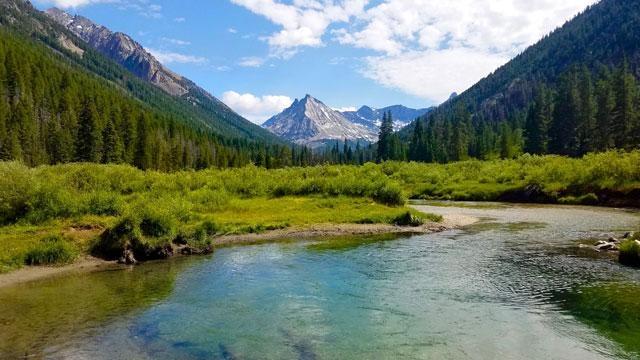
Behind the Scenes
Photos from The Pioneers - as Rugged as the Name
November 10, 2017
I'll confess up front - I knew next to nothing about the Pioneer Mountains before working on our new show, "Into the Pioneers."
At a very young age, I had become enthralled with the Sawtooths - and later the White Clouds - and seldom ventured beyond those mountains. Never felt the need.
I now know why so many people love the "Pios." They have everything, from big mountains to big fish, from big game to big cirques, big meadows and impressive changes in terrain.
Like many others, I had thought of the Pioneers as mainly a series of foothills. Little did I know that these mountains - positioned between glamorous Sun Valley and desolate Craters of the Moon -- are Idaho's second highest range, with a crest of about 11,000 feet. Only the Lost River Range is higher.
The Pioneers also hold the distinction of having the highest named lake. We hiked up to Goat Lake - elevation 10,438 -- on July 27 to discover that a third of the lake was still frozen over. And every day we were there, we got to experience a good old-fashioned summer storm, complete with wind, rain, lightning, and hail.
One can't help but be impressed with the "feel" of the place. It's not official wilderness, but it's every bit as wild as the congressionally designated wildernesses of the Sawtooths, the Boulders, and the White Clouds.
I was delighted that so many of my colleagues wanted a piece of the action. Melissa Davlin organized a group that successfully summited Old Hyndman, braving the infamous black dike.
Marcia Franklin and her team followed world champion cyclist Rebecca Rusch for a bike race up Trail Creek and through Copper Basin. And videographers Jay Krajic and Peter Morrill hit some high mountain lakes on their own, bringing back exquisite video. They also joined a group of us who hiked up to Pioneer Cabin to catch the solar eclipse on August 21. About 30 others had the same idea; and no one left disappointed.
But these special places really come alive for us when we meet the people who love them and spend time in them. And by that standard, the Pioneers are an Idaho masterpiece. We've included many of these "characters" in our hour-long tribute to this mountain range
As one of them said to us while sitting on a horse near Copper Basin, "My soul is happy here. When you see these peaks, you feel like you're completely in God's country. This place feeds your soul."
November 28, 2017
It's been said that retirement is about paying yourself for what you like to do. I've always enjoyed hiking in Idaho's mountains. In fact, my cousin once said with his strong Kentucky accent, "I've been following you on Facebook…, and from what I can tell… you live outside." So, after spending the requisite one to two years figuring out how to be retired, I decided to volunteer for Outdoor Idaho. I've always enjoyed the show and thought this crew must really have the dream job.
As a volunteer, my salary demands were consistent with the crew's budget and expectations, and I received an email one day - we're doing a shoot up in The Pioneers. Game on! After a briefing on the trip logistics, I took some time to assess my hiking gear. While raising a family, the majority of my more recent hiking and camping has been relegated to day hiking and glamping. My lightweight gear suitable for longer treks was old enough that the models were described on Craigslist and eBay as "vintage" or "classic". Time for a few upgrades.
After a thorough review of my various skills, it was agreed that I would carry equipment for the shoot. I was basically a "mule." This must be a perfect fit, because my wife has been calling me her mule for years. As a mule, I think you have to own it. No reason to refer to yourself as Sherpa, Videographer Assistant, Grip, or some title that implies an advanced skillset. Nope, set appropriate expectations. I'm "The Mule." I capitalize it now, as it has become both a title and a handle.
I went on four different shoots in the Pioneer Mountains this summer. The shoots were from two to four days long, and usually began with a long drive to the trailhead followed by an ascent to base camp. The base camp hike is usually the hardest part of the journey, as we hike heavy and climb significantly to a location that puts us in good position for the next days of shooting. From base camp, we can just hike with daypacks and camera equipment. On the last day, we hike back out heavy.
Apparently, "Pioneers" is an old Indian phrase that means "hails every day." We were greeted almost every day with a brief period of small, wet marbles. I'm glad I bought a new tent, but I also discovered a hole in my down sleeping bag. One morning, I noticed feathers scattered on my tent floor. When I emerged from the tent, I must have looked like Sylvester after he got his mouth around Tweety. This wasn't the biggest sleeping bag drama of the summer though, but I'll leave that story for someone else to tell.
As The Mule, my job is to carry the camera tripod -- which I named Bertha - and follow the videographer. Meet Jay Krajic, the James Brown of the crew - the hardest working man in videography. Outdoor Idaho features some amazing video scenes, and there is no climb or scramble that he won't take to get the perfect shot. I know this for a fact, because Bertha must follow closely behind!
Bertha is the commercial grade camera tripod. She provides the stability critical for high quality footage, but she's somewhat of a beast: long, heavy, weighted at one end, and awkward.
Put it this way: she's the equivalent of a steel mountain bike with iron handle bars, and equally as useful in the steep mountain terrain. I so badly want to redesign her with carbon fiber and titanium, but I suspect the project is beyond the Outdoor Idaho budget. (Your Idaho Public Television donations would be helpful here.)
Here's a typical assignment: as we hike up the trail, Jay, Bertha, and I scurry up the trail until Jay finds a good vantage point. We'll climb up on a rock outcropping, side hill, or somewhere else useful and set up the camera to capture our hiking subjects on their journey. We film them as they go by, put the gear away, scurry up the trail to catch back up, surpass the hikers, scurry up the trail again, and repeat.
I visualize this as the tortoise and the hare, but one of our guests called us pronghorns. I'm not sure which analogy is more correct, but we get a little extra mileage and exercise from the process.
The hare had some difficulty in my first outing during our ascent to Baptie Lake. For this trip, we had outfitters with a horse and mule team that were transporting some gear up to our base camp. After getting some footage of the outfitters packing the animals, we hustled up the trail to position ourselves for some additional outfitter footage. We ran into some downfall on the trail, so we tried our best to clear the trail for the animals.
It was then that we discovered the outfitters were using a parallel trail to head up the valley. So we virtually ran up the trail to find some clearings where we had line-of-sight to the opposing trail. We managed to salvage the afternoon with a few unobstructed shots, but we paid the price later.
As is often the case, the mountain curls up towards the top and the trail becomes steeper. We had about a 3,000 foot climb that day, summiting at over 10,000 feet. As we ascended beyond 9,000 feet, Jay and I both took a couple of breathing stops that day.
The other time that I felt the limits of fatigue was on the solar eclipse outing to the Pioneer Ski Cabin. Root cause of the fatigue was actually the journey the prior week to Old Hyndman Peak. The climb to Old Hyndman was incredibly steep, surprising even the experienced climbers with us, and included ascents through scree and a loose boulder field.
After conquering the "black dike" - a geologic term - and summiting the peak, we began the arduous trek back down to base camp. The loose boulders on the descent forced us to travel over boulders, jumping from large boulder to large boulder and avoiding the smaller boulders which were loose and sketchy. Occasionally even a large boulder would give way on the landing, triggering an emergency for my feet and legs. In the end, we accomplished our goals while receiving a rather impressive plyometric workout.
Before these outings, I was guilty of being completely unfamiliar with the Pioneers. I didn't know what to expect, but the views were breathtaking and rivaled the Sawtooth Mountains!
I enjoyed the hikes in the mountains and the comradery. Packing the equipment and scurrying around the mountain takes some grit. I was carrying more weight than a typical backpack trip and in more of a hurry, and of course, the mountains of Idaho are pretty rugged.
The pleasant surprises were the crew and the show guests. The Outdoor Idaho crew is a great bunch of people and a lot of fun. I really enjoy being part of the team and look forward to more opportunities. I also enjoyed meeting the guests for the different show segments. You'll get to meet them, too, if you watch the episode. They were all very interesting and accomplished people, and I enjoyed the talks around the campfire.
In comparison, my life seems pretty boring, but then again, I'm just The Mule.
Photos from It Takes a Videographer like Jay Krajic to make it look Effortless
November 28, 2017 (With permission from The Idaho Statesman)
Hiking with Jay Krajic put me in mind of what fans say of Ginger Rogers dancing with Fred Astaire.
She had to do everything Astaire did - but backwards, and in heels.
In Jay's case, he backpacks just the same as everybody else on an Outdoor Idaho video shoot, but he also packs the camera, batteries, tapes and mics, and has to scamper ahead and around and aside as the rest of us just keep walking.
He's the videographer for Outdoor Idaho who gets the assignment when the assignment is backpacking or climbing a mountain.
Or in the case of our August trip, both.
I got to watch Jay in action on a three-day trip for "Into the Pioneers," an hour-long show exploring the many aspects of the mountain range east of Sun Valley. Idaho Public Television reporter/host Melissa Davlin invited me and my daughter, Helen, along to climb 11,775-foot Old Hyndman Peak. We joined her, Jay, Outdoor Idaho volunteer "mule" Terry Lee (another unsung hero, packing Jay's tripod) and Mat Erpelding who, along with being the minority leader in the Idaho House of Representatives, is a professional climbing guide and instructor.
It was a great group and a fun trip, more fun still because we got to get up into the magnificent, wild, little-visited Big Basin and climb Old Hyndman, the shorter but more challenging sibling of 12,009-foot Hyndman Peak.
And more fun still to get to know Jay and watch the master at work.
He made me realize how little we actually see or understand about what goes into one of these remarkable shows. You never see the crew, who have to hide or maneuver to stay out of every shot. We get to hear host Bruce Reichert's lilting voice-over, introducing gorgeous aerial footage and view after view of mountains and rivers and hikers and wildlife.
Behind the camera, never seen by their audiences, Jay and his fellow videographers make it look effortless. Smooth. Seamless.
I'm here to tell you, that's not reality.
Jay's preference is a 17-pound video camera. He carries that behemoth because it gives him more manual control than do newer, smaller, lighter cameras. It's big enough, and he needs it often enough, that he carries it at his side, like a mountain-man briefcase. Up trails, over rocks, across boulder fields, wading through creeks and spidering up crevices that require two free hands for the rest of us.
"The focus, the aperture, you're in charge of everything you need to be in charge of," he told me. "Those little cameras, they want to be in control."
Jay grew up in Chicago and moved to Utah to study to be a meteorologist. But he fell in love with landscape photography.
"I bought a camera, and the rest is history."
He got a degree in photography from Utah State, and a skier friend suggested he try TV. He went back to school for a degree in broadcast journalism. He did brief stints at stations in Utah and Twin Falls before landing in Boise 30 years ago, where he worked for news stations and as a freelancer before joining Idaho Public Television full time in 2007.
He'll do six or eight or more Outdoor Idaho trips a year, and it's hard to mention somewhere in Idaho he hasn't explored.
"That's why I live here," he said. "I can't leave, because it's the perfect setup.
"I'm two and a half or three hours from so many wilderness areas. And there's nobody there! You can have the whole area to yourself."
One of his most memorable assignments was exploring the headwaters of the Snake (a 60-mile horseback trip into the farthest reaches of Yellowstone National Park and the Teton Wilderness) and Selway (40 miles into the northernmost part of the Frank Church) rivers for the "Idaho Headwaters" show.
"Both of them were really cool because .001 percent of the population even goes there. Nobody ever goes to these places, because they're so remote," he said.
And as he talked, I realized that he doesn't get to just work outdoors. His job takes him to the most beautiful, most remote parts of one of the most beautiful, most remote states in the entire country.
So it's a great job. But it also can stink. Long, dusty trails; hours and hours on a pack string; bad food; cold, wet shoots; lots of travel on really slow, rocky roads. Oh, and leaving the camera's memory cards six miles back in the car at the trailhead.
So, not always glamorous.
"It's not. But - how to put this into words? - it's brutal, and it's hot, but you get these moments where you just get to relax and capture what's there, and kinda forget momentarily about how horrible it was."
At 6-foot-1, 170 pounds, he's light and lean, his long strides moving him as fast or faster than those of us not weighted down with 25 pounds of extra documentary gear. He says he goes slightly slower at age 58 than he did a decade or two ago, but that's not apparent to fellow hikers.
"I sometimes think we're one sprained ankle away from being out of the game," Reichert said. "Thank God Jay keeps himself in shape. He's an unstoppable artist, always willing to do what has to be done to get us a great show."
He's sort of a legend at Idaho Public TV, for his strength, stamina and commitment to getting just… one… more… shot. And yes, perhaps, from the perspective of his fellow hikers, he can be a little too exacting. But for viewers of "Into the Pioneers" and other Outdoor Idaho episodes, it's one more breathtaking view of Idaho landscape that looks, like Ginger and Fred on the silver screen, effortless.
Photos from Memories are Made of These
November 28, 2017
When I first heard about the Copper Basin in the early '80s, I looked over a map - you know, those paper things people used back in those days - to get an idea of what to expect. I saw that Copper Basin was a relatively flat area at about 7,500 feet elevation. In my mind that meant a forested area with a couple creeks running through it. What a surprise to find no trees to speak of and a lot of sagebrush and grass. Perfect for pronghorn! And I saw many of them racing across the basin.
But I never really explored the mountains surrounding the basin - until this year - when I joined the Outdoor Idaho team on one of their jaunts into some high mountain lakes in the Pioneer Mountains.
Wow! Rugged peaks… crystal clear creeks… and spectacular lakes, including the highest named lake in Idaho, Goat Lake, which still had ice on it in late July!
This wasn't my first outing with the Outdoor Idaho crew. I've gone with them to the White Clouds, the Sawtooths, the Boulders, and the Gospel Hump Wilderness. Each of these areas exhibits a unique interpretation of the Idaho backcountry. But, there are common threads that make me look forward to next year's adventure.
Wildflowers! Many places in the backcountry are carpeted with flowers. The colors and textures can be breathtaking; and the flowers add a micro dimension that offsets the vastness of the mountains. It often amazes me that flowers can grow in rocky places that seem devoid of soil.
Fishing! High mountain lakes are a lot of fun to fish. The water is crystal clear and it doesn't take long after arriving at a lake to determine if there are fish inhabiting the water. When they are there, it's usually pretty easy to pull some out.
One of the nicest things about our visit to Goat, Baptie, and Betty lakes was that we pretty much had them all to ourselves. That meant solitude… and no competition for the fish that populated the lakes!
It's become a running joke with the Outdoor Idaho crew that if they need video of fish being caught, they call me. Catch fish on cue, they say. Well, I often do catch fish, but it's only because I'm persistent. However, I can tell you that there is a lot of pressure when you are fishing with a camera looking over your shoulder!
Food! Another common thread on these Outdoor Idaho backcountry trips is Bruce Reichert's famous chicken piccata. The recipe apparently calls for about five pounds of butter. Well, maybe it's not that much, but I'm certain that I get my entire annual allotment of butter on just one of these trips. Hey, I don't want to sound like I'm complaining, because the piccata is delicious, and any dish with capers, shallots, garlic, parsley, and wine is high on my list of tasty meals. I figure, after some of the hikes we do, a little extra fat won't do much damage. And this time Bruce even shared his springtime catch of morel mushrooms with the group. That chicken picatta was the best meal I think I've had at 10,000 feet!
Hard work! By the Outdoor Idaho crew, that is. These folks manage some amazing feats carrying heavy equipment up to some pretty remarkable places. Think about climbing a steep, scree covered mountainside with a pack on your back, a high definition camera in one hand, and a 20 lb. tripod in the other. Does that sound like fun? Well, fortunately for OI fans, it's a common occurrence that lets us enjoy some spectacular Idaho scenery we might otherwise never see.
I haven' yet heard what next year's destination will be, but I'm already getting excited about the adventure. Hiking, fishing, and enjoying spectacular scenery in some of Idaho's most rugged country with a crew of very talented and dedicated people - it sure makes for wonderful memories.
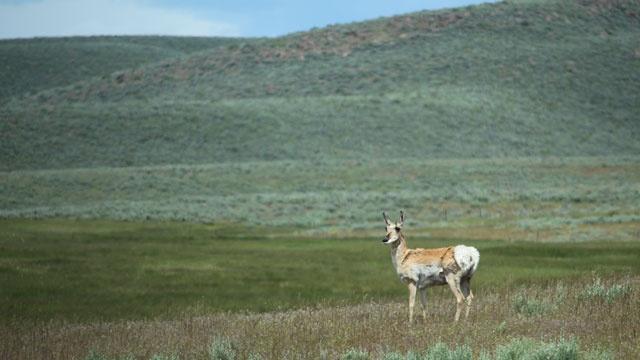
Pronghorn
Pronghorn are North America's fastest mammal - capable of speeds approaching 60 mph - yet they can't seem to distance themselves from the moniker "antelope."
"The first guy who came along thought they looked like antelope," said Todd Stefanic, biologist for the Craters of the Moon National Monument. "When you first get to describe a species, you get to choose the genus species. And he decided antilocapra americana was going to be a good name. Only later did we realize they're not antelope. Antelope live in Africa. This thing's closest relative is actually a giraffe!"
We interviewed Stefanic for our show, "Into the Pioneers." We were intrigued by his description of "pronghorn pass," on Craters of the Moon property.
"I know between which sagebrush and which rock they're going to come every spring and every fall. It's the narrowest constriction point for pronghorn migrating from their winter range on the Idaho National Laboratory, over in the big desert, over to their summer range, north of Carey," he says.
Stefanic has set up three cameras, to catch their migration. "It's an extremely unique opportunity. I can count every animal coming and going each spring and fall. It's a pretty beaten down trail, and they come through here single file. They've got a leader, and they get behind them, and they're not messing around. I think they're worried about predators here in the mountains to the north of us and Sunset Cone to the south, and all this rocky stuff around here. So they get in single file line, and they'll do this in a day, from one end of Craters to the other, about nine miles. And they'll make that in a day. They want to get back to the flat plains, where they can see a long ways and run fast and get away."
Stefanic may not know the exact day the pronghorn will come through Pronghorn Pass – that depends on the snow level in their winter range – but he does know the time of day. "In the spring, when they're going to their summer range, they're going to come through here between 11:00 a.m. and 12:00; that's the peak. When they're going the other way back to their winter range, it's around 2:00 in the afternoon."
There are a lot of "gee-whiz" facts about these skittish creatures that inhabit the Pioneers. Early explorers called them "speed goats." They can cruise along at 45 miles an hour. "They can do short bursts of 60 miles an hour," says Stefanic. "But not many people know the reason for that speed. It's because there used to be a North American cheetah, and that was their main predator, and they had to be faster than them."
They receive their name from their pronged horns, which are hollow, unlike antlers. Both sexes sport those backward-curving horns, which split to form forward-pointing prongs that give the pronghorn its name.
And they don't like to jump fences, which can be a real problem for ranchers, who rely upon fences to keep their animals enclosed. "They never evolved out on the plains having to jump anything," says Stefanic, "so they come to a fence, and they would often stack up and not know what to do. So they want to go under a fence. So now when we build a fence out here, the bottom wire is 18 inches off the ground, and it's smooth wire, no barbs.
"In fact, there's instances in Wyoming, when the early settlers came, and they were going to raise sheep, and they built these woven wire sheep fences. And unbeknownst to them, they built it across the migration route. When the pronghorn came back to migrate, they stacked up along the fence and starved to death by the hundreds because they wouldn't jump that fence."
Another gee-whiz fact about pronghorn: "They have this incredible eyesight," says Tess O'Sullivan of The Nature Conservancy. "They can detect humans and other things from three to four miles away. They're a fairly small animal, but their eyeball is as large as a horse.
"And they have these incredibly dense bones. Compared to a cow, their bones are twice as dense and half as wide or large," says O'Sullivan. "That helps them be able to run across at such speeds."
O'Sullivan says adult pronghorn keep the fawns hidden in the sagebrush, "because if they're detected, they're just really vulnerable. So the moms will leave them and come and nurse for 30 seconds and then leave them for five hours."
If you come across a fawn, don't assume it's been abandoned. O'Sullivan's advice: "if you ever are lucky enough to happen upon a small animal that's just hidden in the sagebrush, just take a quick look and then back away and leave it alone."
Oh, and if you want to get a photograph of this elusive creature, you might want to wear a white shirt. "They like white," says O'Sullivan; "it's an attractant, for sure. I've heard this from multiple people."
Now about their migration, which is quite remarkable in itself. During 2008-2011, a team of researchers used GPS tracking collars to reveal one of this animal's longest migration routes. Scientists from the Wildlife Conservation Society, the Lava Lake Institute, Idaho Department of Fish & Game, and the Pioneers Alliance mapped a route that passes along the northern edge of the Craters of the Moon National Monument and Preserve (see map below).
Every spring hundreds of pronghorn travel west to reach their summer range in the Pioneer Mountain foothills. In the fall, they head back to their winter range near Arco and the Idaho National Laboratory.
"It's also unique because, unlike how people think of most migration as being a north south movement, this is an east west movement," said Todd Stefanic. "It's based more on elevation than latitude. They're going up into the foothills of the Pioneers, north of Carey, and that's where they're going to spend their summers."
For the last several years, Stefanic has been studying their migration patterns by documenting their movements near Craters of the Moon, using motion-activated cameras. He calls them "inconsistent migrators," because their migration patterns can change from year to year.
"They don't have that great of a fidelity to a winter range, so they may choose to leave the winter range on the Idaho National Laboratory and follow somebody going this way. They might go up Birch Creek or up to Lemhi to a different summer range. And we haven't quite got a handle on that yet. It would take a whole lot of GPS collars to figure that out! They're one of my favorite animals to study. There's just so much about them that is unique and different."
And, unlike some animals, the pronghorn seem to be thriving, as scientists, land managers, and ranchers learn more about this unusual creature.
"I am optimistic for the pronghorn," says Nature Conservancy's Tess O'Sullivan. "I do think they have a lot of great habitat. I think the biggest challenges they're facing are the winter range and their migration corridor. But of all the wildlife species, they seem to be doing pretty well."
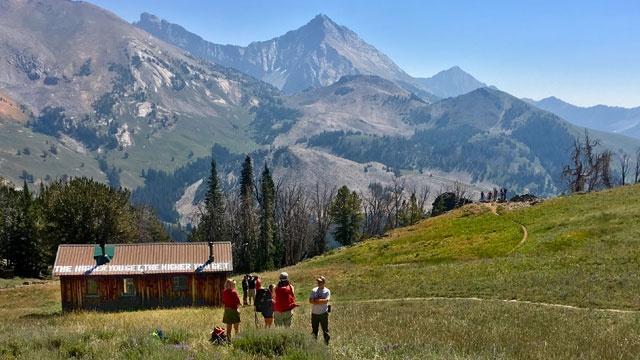
Pioneer Cabin
Originally built in the summer of 1937 by Averell Harriman and the Union Pacific Railroad as a ski touring hut, the Pioneer Cabin is today the most popular alpine day hike in the Valley, as well as a favorite destination spot for hikers wanting a taste of the Pioneer Mountains.
Indeed, at 80 years of age, Pioneer Cabin is not only the first 'Sun Valley Country' backcountry ski hut; it may be one of the first in America.
Averell Harriman of the Union Pacific Railroad wanted to build a destination ski resort at Sun Valley that took the "drudgery" out of skiing. That meant a resort with chair lifts and groomed trails. But being a consummate businessman, he also wanted to replicate the exact European ski experience that he and his Gilded Age friends knew at resorts like Chamonix, Gastaad and St. Moritz. In that day, off-piste, or 'alpine touring' into the surrounding mountains, was as popular as using the limited mechanical conveyances of the day to access skiing at the toe of the famed resorts.
Harriman hired some Austrian and German skiers to help get his ski resort off the ground. Many of these European instructors had a history of alpinism, both as climbing and alpine tour ski guides, and were therefore naturals for Harriman's Alpine Tour Ski School. These guides led guests on day routes around the Valley and to the first alpine huts Harriman built, beginning with Pioneer Cabin in 1937 and followed by Owl Creek Cabin in the Smoky Mountains and Boulder Hut in the Boulder Mountains.
"They were the best in the world as ski instructors," said Joe St. Onge, co-owner of Sun Valley Trekking. We interviewed St. Onge in the Pioneers near Pioneer Yurt. "And they got here and looked at Dollar and Ruud Mountain, where the lifts were, and they scoffed. And they looked up here and they said, 'we should be skiing up there, no?'
"And you know what happened, within two years? They built the Pioneer Cabin; they put a cabin up on the ridgeline to access these mountains."
The cabin sits at 9500 feet and requires a strenuous 2600 foot climb over four miles. Most people visit the cabin via the Pioneer Creek Trail, up Corral Creek Road off of Trail Creek Road. The reward is one of the most impressive views of the Pioneer's alpine crest, a triad of pyramid shaped peaks - Hyndman, Old Hyndman and Cobb – being the most prominent.
Actually, the cabin can be accessed by two routes via the Corral Creek Trailhead: the direct face and Long Gulch routes. There are also two routes via Hyndman Creek: one up Johnstone Creek and the other the north fork of Hyndman. This makes for a loop hike from either the Corral Creek or Hyndman Creek side.
Bob Jonas grew up in the Sun Valley area; his parents met and worked during Sun Valley Resort's 1936-37 inaugural winter season. Jonas and his brother grew up with many of Sun Valley's ski instructors, including those from the Army's 10th Mountain Ski Division. "We knew most of these guys," said Jonas. "Some were neighbors and we taught with them as a Sun Valley ski instructor in the 1960's."
That's when Jonas began visiting the Pioneer Cabin. "I began visiting the cabin in all seasons during the '60's, most often as a spring-time backcountry skier. I do not recall words of any kind on the cabin's roof until one day being enchanted to come over the buckle in the trail just before the cabin and be slammed by 'The Higher You Get the Higher You Get.'"
Early photos of the Pioneer Cabin show different wording. "I did a little research and have some leads," said Jonas. "In looking at some old photographs, I note the word "Ski" on the partly buried cabin roof. It's probably 'Ski Heil,' a phrase common in Europe, which means, 'good skiing.'"
Upon further research, Jonas discovered this. "I finally got the story from Gordon Williams, long-time valley mountaineer. He and his friend, nature and conservation photographer Robert Ketchum, created the words during a work trip in the 70's to repair the cabin's leaky roof and repair the interior. The impetus for their trip was the Forest Service's 'cabin burn' policy of the 70's. This policy threatened Pioneer cabin unless volunteer forces maintained it, which has been the case ever since."
Gordon Williams also confirmed to Jonas that he and his climbing buddies came up with the whimsical 'Decker Flat Frisbee & Climbing Club.'
"Another work trip in the early nineties," said Jonas, "was led by members of the Galena Backcountry Ski Patrol. They replaced the existing roof with a metal one and laid-out the marquee words very prominently across the entire roof. Michael Kraynik was a member of this work party. Soon after the words were up, Michael got the message they had been erased. So he scrambled up with friends and repainted the roof. The words have stood ever since."
While some may wonder if the words on the roof are drug related, Bob Jonas and Gordon Williams say it's all about that "mountain high" that keeps folks coming back time after time.
The Outdoor Idaho crew visited the Pioneer Cabin in August of 2017. We knew it was an important part of the Pioneer Mountain story, and that it would be in the path of complete totality for the solar eclipse of August 21. It turned out to be the perfect place to be on that day. We shared the experience with about 30 other people.
"This is one of my favorite spots on earth," said Andrew Myers, one of those who made the trek. "This view of the Pioneers, the Pioneer range in and of itself, it's one of the greatest places I've ever been."
Jim Mazzoni, his wife and daughter also viewed the eclipse from Pioneer Cabin. "It's just spectacular. It will be something that we'll talk about for many years," he said. "Later on in life we'll just say, 'do you remember when?' What a beautiful opportunity to be out here at Pioneer Cabin."
The cabin is more than just an enduring legacy to early Sun Valley and America's ski history. Of course, the original amenities have long since disappeared. No more Pullman compartments for bunk beds; no more comfortable mattresses or gourmet meals or expert guides. But it is still open to the public - on a first come, first served basis - and today sports an impressive collection of graffiti on the interior walls.
"It steals the breath, lights the mind and heart, inspires poetry and engages lovers," says Bob Jonas. "No surprise the cabin's walls, ceiling, rafters, spare furnishings, and its many logbooks sing praise and share wisdom."
But Jonas cautions that the fate of the Pioneer Cabin "seems to rest with local volunteers." There is no government agency watching over this cabin.
Luckily, Jonas says, folks seem to care. "They periodically repair the exterior and interior, including re-painting and garbage removal. This was the case during my September 2017 llama trip overnight visit. The south end of the two room cabin had been freshly painted in white, yet the walls and cabinets were almost completely covered by 2017 signatures and graffiti. We cleaned up the interior, hauling off 3 llama packs full of garbage."
Tom Lopez, the author of the definitive book on climbing Idaho's mountains, has visited Pioneer Cabin many times. "I have climbed all over the state," said the author of Idaho, A Climbing Guide; "and in my opinion the view from the cabin east to the Pioneer crest is the most impressive alpine view in the entire state."
Now that's a recommendation!

Related Links
- The Nature Conservancy
- Lava Lake Institute for Science and Conservation
- Pioneers Alliance
- Ketchum Ranger District, USFS
- Salmon-Challis National Forest
- Wood River Wolf Project
- Wild Gift
- Trailing of the Sheep Festival
- Rebecca's Private Idaho
- Idaho: A Climbing Guide
- Craters of the Moon National Monument and Preserve
- Idaho Statesman: Videographers like Jay Krajic make "Outdoor Idaho" look effortless
- Teton Gravity Research: From the 1930s to Today, Sun Valley has Cultivated a Backcountry Culture Unlike Anywhere Else
Photos from Into The Pioneers
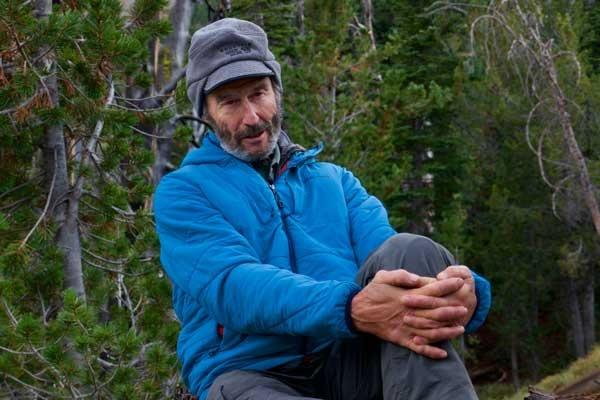
Credit: Peter Morrill
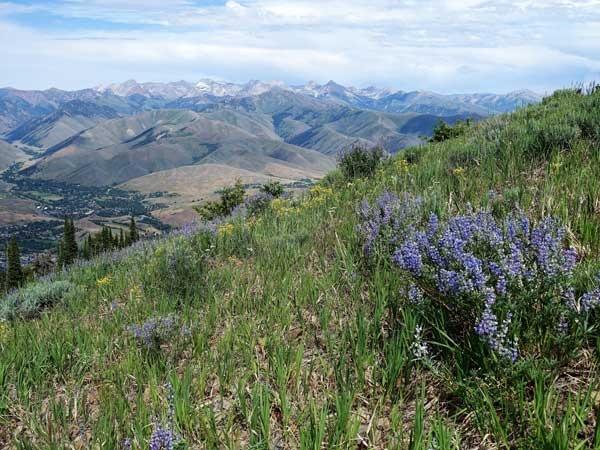
Credit: Jay Krajic

Credit: Bruce Reichert
